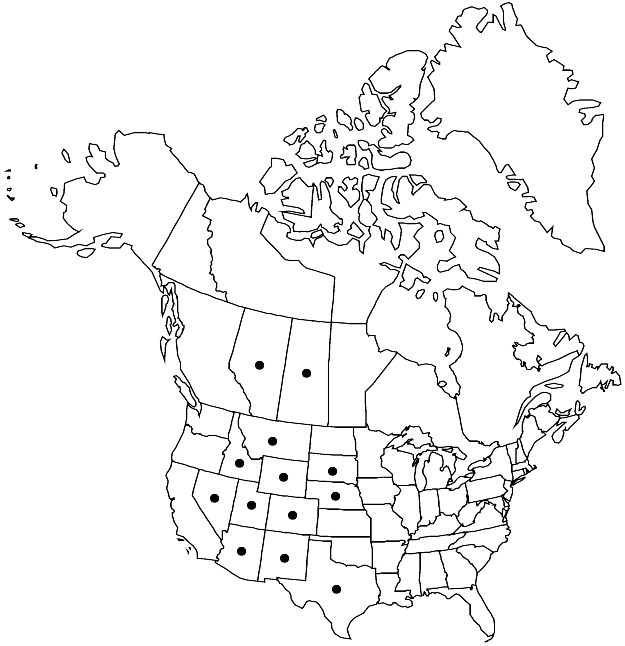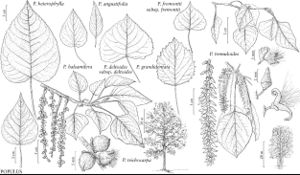Populus angustifolia
Account Exped. Pittsburgh 1: 497. 1823.
Plants to 20 m, 7 dm diam.; moderately heterophyllous. Bark light brown, shallowly furrowed. Branchlets orange-brown, becoming whitish tan by third year, round or 5-angled, 1.5–2.5(–3.5) mm diam., not coarse, glabrous. Winter buds reddish brown, glabrous, resinous (resin red, fragrant); terminal buds (3–)6–9(–13) mm; flowering buds clustered distally on branchlets, 8–12(–18) mm. Leaves: petiole round, adaxially slightly channeled distally, 0.2–0.8(–1.7) cm, 1/8–1/5 blade length, (glabrous); blade usually lanceolate to narrowly ovate, (1.5–)4–8(–13.5) × 0.8–2.5(–4) cm, w/l = 1/5–1/2, base acute to rounded, basilaminar glands 0, margins not translucent, not ciliate, apex acute, abaxial surface whitish green, weakly glaucous, adaxial dark green, glabrous; preformed blade margins subentire to minutely, evenly crenate-serrate throughout, teeth (14–)23–35(–65) on each side, sinuses 0.1–0.3 mm deep; neoformed blade margins finely crenate-serrate throughout, teeth 35–65(–80) on each side, sinuses 0.1–0.6(–1.5) mm deep. Catkins ± densely 35–50-flowered, 3–8(–9 in fruit) cm; floral bract apex deeply cut, not ciliate. Pedicels 0.5–1.5(–3 in fruit) mm. Flowers: discs shallowly cup-shaped, not obviously oblique, entire, 1–1.5(–3) mm diam.; stamens 10–20; anthers truncate; ovary 2-carpelled, ovoid to spherical; stigmas 2–4, broad, expanded. Capsules broadly ovoid to spherical, 3–5 mm, glabrous, 2-valved. Seeds (2–)4–7(–9) per placenta. 2n = 38.
Phenology: Flowering Apr–May; fruiting Jun–Jul.
Habitat: Streamsides in mountains and foothills
Elevation: 1500-2400(-3300) m
Distribution

Alta., Sask., Ariz., Colo., Idaho, Mont., Nebr., Nev., N.Mex., S.Dak., Tex., Utah, Wyo., Mexico (Chihuahua, Coahuila, Sonora).
Discussion
Populus angustifolia has been mistakenly reported from eastern California and eastern Oregon based on intergrades with, and narrow-leaved specimens of, P. trichocarpa in those arid regions. It is a characteristic species of the Rocky Mountains, extending onto the plains and overlapping in canyon mouths as they exit the mountains with two North American species of sect. Aigeiros, P. deltoides and P. fremontii, and hybridizing with each of them. It also hybridizes with the other two native species of sect. Tacamahaca, P. balsamifera and P. trichocarpa. The hybrid with P. balsamifera, P. ×brayshawii B. Boivin, differs most obviously in longer petioles, at least 2.5 cm, and is increasingly common from Colorado northwards, largely replacing P. angustifolia in southern Alberta (T. C. Brayshaw 1965b; S. B. Rood et al. 1985). The hybrid with P. trichocarpa (unnamed) is uncommon and largely confined to the Great Basin region, including Montana (W. W. White 1951). Populus angustifolia does not hybridize naturally with P. tremuloides, as sometimes reported (B. Boivin 1966b). The specimens that formed the basis for that report are long shoots of P. angustifolia with relatively coarsely toothed neoformed leaves.
Populus ×acuminata Rydberg is the intersectional hybrid of P. angustifolia with P. deltoides (sect. Aigeiros) that occurs on floodplains of major streams, primarily along the foot of the Rocky Mountain Front Ranges where these species grow together, but also extends onto the plains and Colorado Plateau (Alberta, Arizona, Colorado, Montana, Nebraska, New Mexico, North Dakota, South Dakota, Texas, Utah, and Wyoming) (J. E. Eckenwalder 1984). As with other cloning hybrids, it can often occur without one or both parents. It differs from P. angustifolia in larger, ovate leaves with coarser teeth, less color differentiation between abaxial and adaxial surfaces, and longer petioles that are slightly flattened side to side near the junction with the blade. Because of its frequency and morphological consistency, P. ×acuminata was first described as a species and is often treated as such in local and regional floras. It was long suspected of being a hybrid, and its hybrid origin was amply confirmed by multiple lines of evidence in the 1970s and 1980s (D. J. Crawford 1974; A. G. Jones and D. S. Seigler 1975; S. B. Rood et al. 1985). The name has also been widely misapplied to intersectional hybrids involving other combinations of balsam poplar and cottonwood parents (Eckenwalder).
Populus ×berolinensis Dippel is a similar cultivated, introduced, intersectional hybrid between two Eurasian species, P. laurifolia Ledebour (sect. Tacamahaca) and P. nigra Linnaeus (sect. Aigeiros). It has an upright growth habit and leaves similar in shape to those of P. ×acuminata, but more balsam poplar-like with smaller teeth and greater color differentiation between abaxial and adaxial surfaces. Pistillate individuals may hybridize with native species of both parent sections (W. G. Ronald and J. W. Steele 1974).
Populus ×hinckleyana Correll (synonyms P. ×acuminata nothomorph rehderi Sargent and P. ×intercurrens S. Goodrich & S. L. Welsh) is the intersectional hybrid of P. angustifolia with P. fremontii (sect. Aigeiros) and is moderately common in canyons throughout their range of sympatry (Arizona, Idaho, Nevada, New Mexico, Texas, Utah, and Mexico [Chihuahua, Sonora]). At the type locality in the Davis Mountains, Texas, P. angustifolia is now absent, and the cottonwood parent is P. fremontii subsp. mesetae, but other occurrences have arisen through hybridization with P. fremontii subsp. fremontii (G. C. Bennion et al. 1961; J. E. Eckenwalder 1984; P. Keim et al. 1989). It differs from P. angustifolia in hairy young shoots and a broader floral disc.
A related Eurasian species, Populus simonii Carrière, is moderately commonly cultivated, especially in the form of a broadly pyramidal staminate clone (‘Pyramidalis’). It shares the slender, often 5-angled twigs and relatively small leaves of P. angustifolia, but differs most noticeably in elliptic blades of preformed leaves and obovate blades of neoformed leaves.
Selected References
None.
